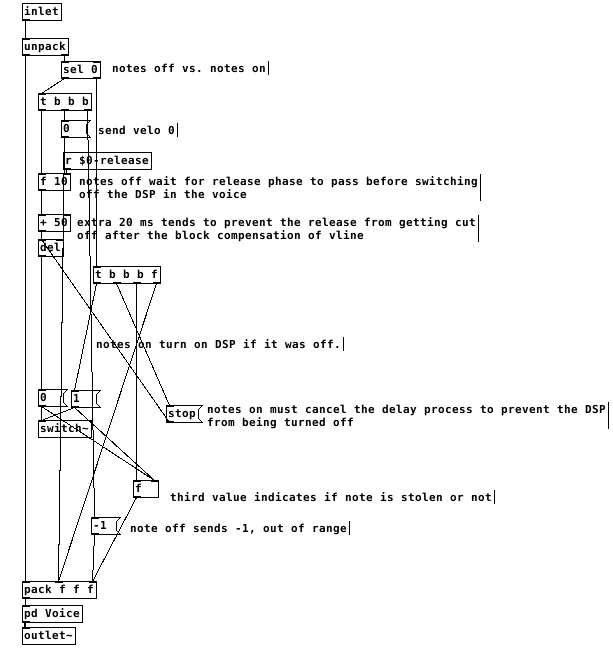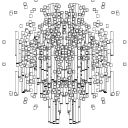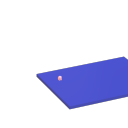Too many bangs or wrong note on onset for granular synth
@morpheu5 Your clones are identical. There are two incoming messages that change their operation.
[next $1( and [r $1-grainSpeed].
But [s $0-grainSpeed] sends to all of them so they all have their speed settings changed at the same time as a note is played (except that they do not without the "cursed" bang..)
With the cursed bang they are all updated for an incoming note...... but all the [vline~] are restarted causing an overload.
Without the cursed bang none are updated until the metro bangs again....... but there will be an indeterminate delay until the metro bangs........ during which time the tail of the previous grain will still be playing the previous note..... and then none of the others will be updated......
Assuming you want all the grain tails to be updated by the note but not be restarted..... (that is how it looks at the moment....... Monophonic.... if not then everything below is untrue).......
........ you will need to bang [vline~] only from the [next $1] message and modify the output of [vline~] before [tabread4~ $1-grainData] with a [x~] for all the other clones..... the value for the [x~] being the relationship between the current and the previous note.
..... And the new note needs to bang the [next $1( message...... not the [metro]
BUT you will not want the multiplier for the newly banged [vline~]....... and your clones are identical...... aargh.
SO in fact you need to get the grainSpeed into the clone as a modifier of the output of [vline~] and not as part of it's received message (so that they all change)....... and only bang one clone to restart one [vline~] at the same time through the [next $1] message..
Doing that you will only need to set the modifier as a value for the note and you will not need to mess around with relative values between notes.......
I think that is it in summary.....
David.
Just got my MIDI Violin! Here are some notes on it and how to use it with PD
@s.elliot.perez
It seems to have a 13 pin midi connector.... but maybe it's not midi data.
There is a miniscule amount of information here...... http://www.cantinielectricviolins.com/2/technical_support_2950879.html
There is an interface here...... https://www.roland.com/us/products/gi-20/ and at least that unit could be necessary to get midi data into Pd.
I think you will need to read this......
https://www.researchgate.net/publication/255569994_ADAPTING_POLYPHONIC_PICKUP_TECHNOLOGY_FOR_SPATIAL_MUSIC_PERFORMANCE
.... and it will probably tell you what you need to know.
If you just want a loud violin you could try an Accusound Omni microphone. That is what I use with the Balanescu Quartet, and we have done pop and even heavy metal gigs.
Or you could try deconvolution with a piezo pickup...... https://forum.pdpatchrepo.info/topic/7778/deconvolution-for-rt-spectral-stamping-of-violin
But if you want some other synthesis then that violin could be a good solution.
David.
(P.....S...... It looks like you can also buy the pickup separately.......)
Lower limit to phasor~ frequency?
@yannseznec there is a limit in precision for any finite numerical representation. However, for floating point that becomes more complicated to calculate. The relevant code is
x->x_biginc = (x->x_target - x->x_value)/(t_float)nticks;
x->x_inc = x->x_1overn * x->x_biginc;
and in the dsp function:
x->x_1overn = 1./sp[0]->s_n;
so the inc will be (target value - current value)/(total time in samples). Time in samples will be rounded to the block size. I believe whether or not this number will increment the line~ depends on how big or small the current value of the line~ is. (again, it's complicated since it's floating point).
for instance if the current value of line~ is 1 then inc would have to be less than 2^-24 to not be able to increment I think. this would correspond to going from 1 to 2 over 16777216 samples, or ~6 minutes 20 seconds @ 44100 samplerate. (so you couldn't go from 1 to 2 any slower than that and have it represent the correct values within the block). Every time the value of line~ doubles so does the smallest representable increment.
however, line~ also uses the biginc variable, which means that after every block it will be able to update using a bigger increment. This means that line~ will still be able to increment up to blocksize times more than that calculation ^ after every block, though values inside every block would be the same. (so ~6 hours 46 minutes @ blocksize 64 according the above calculation I think)
if going from 0 to 1 all of those values would be doubled (it could represent increments corresponding to twice that time, bounded by the lowest representable increment that corresponds to going from 0.5 to 1)
there are other considerations of precision as well. If the increment can only be represented with a certain number of binary digits when added to the current value then there will be round-off errors in the values generated. (but if you need values of that precision you would have round-off errors somewhere else anyways probably)
another numerical bound on the use of line~ is the use of an int to represent ticksleft. If we assume this is a 32-bit signed integer then there can only be 2,147,483,647 blocks, which is ~36 days @ 44100 samplerate and a blocksize of 64. (this would be longer than whatever limitation the floating-point would impose tho I think)
this is all assuming that the size pd uses for samples and floats are 32-bit floating point. If pd is compiled to use 64-bit doubles instead then all of those values would be 2^29 times longer
edit: actually, looking at the code vline~ does use doubles for everything, so if you need really long ramps you should have no problem if you use vline~ instead of line~, even in normal non-double pd. It would take a time longer than 6,472 years for a vline~ going from 1 to 2 to stop being able to increment within a block of 64 samples @ 44.1k. (and a time of 414216 years to stop incrementing at all across blocks)
In the case of vline~ the bounding factor of precision might be in the representation of time actually since it doesn't use ticksleft
edit 2: it couldn't represent incrementing ~1.45 ms which is the time for a block of 64 @ 44100 samples if the current time were ~ 2^53 ms, which would be 9007199254740992, or 285,421 years before stopping to work completely.
long story short: you should be able to use vline~ (but not line~) for ramps of at least a few years long (depending on the range of its values) before it stops incrementing within a block. For the specific case of going from 0 to 1 @ 44.1k, you should be able to run a vline~ for ~129,000 years before it stops incrementing within a block (though it would still increment between blocks)
PD's scheduler, timing, control-rate, audio-rate, block-size, (sub)sample accuracy,
@whale-av said:
It could be tested to see whether its control rate message inlet will take (in msecs) small enough float values to make that happen.
here is a test patch vline-test.pd. vline~ accepts messages at any time with sub-sample accuracy. This is also documented in the help-file.
@lacuna said:
[metro 1 1 samp]How could I have known that? The helpfile doesn't mention this. (Offtopic: actually the whole forum is full of pd-vocabular-questions)
It is documented in the metro-helpfile since pd-0.48 i guess. But i agree, there is not much redundant information in pd's helpfiles, to put it mildly 
But you can „use“ the metro counts every 64 samples only, don't you?
yes, except you use it with vline~ (see test-patch)
When should I use [block~ 1 1 1] and when shouldn't I?
whenever you need delay~ times smaller than 64 samples.
PD's scheduler, timing, control-rate, audio-rate, block-size, (sub)sample accuracy,
@lacuna The whole patch is recompiled within Pd and I think that although the data flow model is fantastic it makes it harder to understand the workings.
The blocks (of audio) are read, or generated, and all of the stuff that the patch needs to do to the block is done all at once to every sample in the block, and then the block is sent onwards.
So if you put [x~ 2] >> [/~ 2] then nothing is done..... the code that Pd is running has done the math and the result is "multiply sample values by one".......... so "do nothing". A complex patch will have been boiled down to "subtract x from sample1" "add y to sample2" etc...... up to sample 64, rinse, calculate the next set of additions and subtractions to apply, and do it to the next block.
Those operations..... add to sample value... or subtract from sample value.... are the only possible operations on a sample value.......
Interpolation uses adjacent sample values for the calculation, but adding or subtracting to / from the sample values is what happens when the calculations have been done.
Some objects like [x~] can be controlled by a control signal, and so the new value can only be applied at block boundaries as the control calculations are done between boundaries. The addition will be the same for every sample in the block. Pd didn't know in advance what it's next value might be, so a ramp cannot be applied across the samples in this block.
Some objects though, like [vline~] are scheduling changes of value that will happen across the block, and future blocks, and may finish at sample 43 within a block. Programmatically it is saying, as part of the whole patch "add a bit to sample 1 (if it has a +ve value or subtract if -ve)) and a bit more to sample 2 etc..... etc... and then for the next block, when the audio program runs again add even more to the 1st sample etc..... until.
So it is sample accurate.
And of course if [x~] is controlled by [vline~] it will do as it is told and be sample accurate too.
You can add a start delay to [vline~] so that it's start point is sample accurate too.
PD's scheduler, timing, control-rate, audio-rate, block-size, (sub)sample accuracy,
Hello, 
this is going to be a long one.
After years of using PD, I am still confused about its' timing and schedueling.
I have collected many snippets from here and there about this topic,
-wich all together are really confusing to me.
*I think it is very important to understand how timing works in detail for low-level programming … *
(For example the number of heavy jittering sequencers in hard and software make me wonder what sequencers are made actually for ? lol )
This is a collection of my findings regarding this topic, a bit messy and with confused questions.
I hope we can shed some light on this.



- a)
The first time, I had issues with the PD-scheduler vs. how I thought my patch should work is described here:
https://forum.pdpatchrepo.info/topic/11615/bang-bug-when-block-1-1-1-bang-on-every-sample
The answers where:
„
[...] it's just that messages actually only process every 64 samples at the least. You can get a bang every sample with [metro 1 1 samp] but it should be noted that most pd message objects only interact with each other at 64-sample boundaries, there are some that use the elapsed logical time to get times in between though (like vsnapshot~)
also this seems like a very inefficient way to do per-sample processing..
https://github.com/sebshader/shadylib http://www.openprocessing.org/user/29118
seb-harmonik.ar posted about a year ago , last edited by seb-harmonik.ar about a year ago
• 1
whale-av
@lacuna An excellent simple explanation from @seb-harmonik.ar.
Chapter 2.5 onwards for more info....... http://puredata.info/docs/manuals/pd/x2.htm
David.
“
There is written: http://puredata.info/docs/manuals/pd/x2.htm
„2.5. scheduling
Pd uses 64-bit floating point numbers to represent time, providing sample accuracy and essentially never overflowing. Time appears to the user in milliseconds.
2.5.1. audio and messages
Audio and message processing are interleaved in Pd. Audio processing is scheduled every 64 samples at Pd's sample rate; at 44100 Hz. this gives a period of 1.45 milliseconds. You may turn DSP computation on and off by sending the "pd" object the messages "dsp 1" and "dsp 0."
In the intervals between, delays might time out or external conditions might arise (incoming MIDI, mouse clicks, or whatnot). These may cause a cascade of depth-first message passing; each such message cascade is completely run out before the next message or DSP tick is computed. Messages are never passed to objects during a DSP tick; the ticks are atomic and parameter changes sent to different objects in any given message cascade take effect simultaneously.
In the middle of a message cascade you may schedule another one at a delay of zero. This delayed cascade happens after the present cascade has finished, but at the same logical time.
2.5.2. computation load
The Pd scheduler maintains a (user-specified) lead on its computations; that is, it tries to keep ahead of real time by a small amount in order to be able to absorb unpredictable, momentary increases in computation time. This is specified using the "audiobuffer" or "frags" command line flags (see getting Pd to run ).
If Pd gets late with respect to real time, gaps (either occasional or frequent) will appear in both the input and output audio streams. On the other hand, disk strewaming objects will work correctly, so that you may use Pd as a batch program with soundfile input and/or output. The "-nogui" and "-send" startup flags are provided to aid in doing this.
Pd's "realtime" computations compete for CPU time with its own GUI, which runs as a separate process. A flow control mechanism will be provided someday to prevent this from causing trouble, but it is in any case wise to avoid having too much drawing going on while Pd is trying to make sound. If a subwindow is closed, Pd suspends sending the GUI update messages for it; but not so for miniaturized windows as of version 0.32. You should really close them when you aren't using them.
2.5.3. determinism
All message cascades that are scheduled (via "delay" and its relatives) to happen before a given audio tick will happen as scheduled regardless of whether Pd as a whole is running on time; in other words, calculation is never reordered for any real-time considerations. This is done in order to make Pd's operation deterministic.
If a message cascade is started by an external event, a time tag is given it. These time tags are guaranteed to be consistent with the times at which timeouts are scheduled and DSP ticks are computed; i.e., time never decreases. (However, either Pd or a hardware driver may lie about the physical time an input arrives; this depends on the operating system.) "Timer" objects which meaure time intervals measure them in terms of the logical time stamps of the message cascades, so that timing a "delay" object always gives exactly the theoretical value. (There is, however, a "realtime" object that measures real time, with nondeterministic results.)
If two message cascades are scheduled for the same logical time, they are carried out in the order they were scheduled.
“
[block~ smaller then 64] doesn't change the interval of message-control-domain-calculation?,
Only the size of the audio-samples calculated at once is decreased?
Is this the reason [block~] should always be … 128 64 32 16 8 4 2 1, nothing inbetween, because else it would mess with the calculation every 64 samples?
How do I know which messages are handeled inbetween smaller blocksizes the 64 and which are not?
How does [vline~] execute?
Does it calculate between sample 64 and 65 a ramp of samples with a delay beforehand, calculated in samples, too - running like a "stupid array" in audio-rate?
While sample 1-64 are running, PD does audio only?
[metro 1 1 samp]
How could I have known that? The helpfile doesn't mention this. EDIT: yes, it does.
(Offtopic: actually the whole forum is full of pd-vocabular-questions)
How is this calculation being done?
But you can „use“ the metro counts every 64 samples only, don't you?
Is the timing of [metro] exact? Will the milliseconds dialed in be on point or jittering with the 64 samples interval?
Even if it is exact the upcoming calculation will happen in that 64 sample frame!?
- b )


There are [phasor~], [vphasor~] and [vphasor2~] … and [vsamphold~]
https://forum.pdpatchrepo.info/topic/10192/vphasor-and-vphasor2-subsample-accurate-phasors
“Ive been getting back into Pd lately and have been messing around with some granular stuff. A few years ago I posted a [vphasor.mmb~] abstraction that made the phase reset of [phasor~] sample-accurate using vanilla objects. Unfortunately, I'm finding that with pitch-synchronous granular synthesis, sample accuracy isn't accurate enough. There's still a little jitter that causes a little bit of noise. So I went ahead and made an external to fix this issue, and I know a lot of people have wanted this so I thought I'd share.
[vphasor~] acts just like [phasor~], except the phase resets with subsample accuracy at the moment the message is sent. I think it's about as accurate as Pd will allow, though I don't pretend to be an expert C programmer or know Pd's api that well. But it seems to be about as accurate as [vline~]. (Actually, I've found that [vline~] starts its ramp a sample early, which is some unexpected behavior.)
[…]
“
- c)



Later I discovered that PD has jittery Midi because it doesn't handle Midi at a higher priority then everything else (GUI, OSC, message-domain ect.)
EDIT:
Tryed roundtrip-midi-messages with -nogui flag:
still some jitter.
Didn't try -nosleep flag yet (see below)
- d)

So I looked into the sources of PD:
scheduler with m_mainloop()
https://github.com/pure-data/pure-data/blob/master/src/m_sched.c
And found this paper
Scheduler explained (in German):
https://iaem.at/kurse/ss19/iaa/pdscheduler.pdf/view
wich explains the interleaving of control and audio domain as in the text of @seb-harmonik.ar with some drawings
plus the distinction between the two (control vs audio / realtime vs logical time / xruns vs burst batch processing).
And the "timestamping objects" listed below.
And the mainloop:
Loop
- messages (var.duration)
- dsp (rel.const.duration)
- sleep
With
[block~ 1 1 1]
calculations in the control-domain are done between every sample? But there is still a 64 sample interval somehow?
Why is [block~ 1 1 1] more expensive? The amount of data is the same!? Is this the overhead which makes the difference? Calling up operations ect.?
Timing-relevant objects
from iemlib:
[...]
iem_blocksize~ blocksize of a window in samples
iem_samplerate~ samplerate of a window in Hertz
------------------ t3~ - time-tagged-trigger --------------------
-- inputmessages allow a sample-accurate access to signalshape --
t3_sig~ time tagged trigger sig~
t3_line~ time tagged trigger line~
--------------- t3 - time-tagged-trigger ---------------------
----------- a time-tag is prepended to each message -----------
----- so these objects allow a sample-accurate access to ------
---------- the signal-objects t3_sig~ and t3_line~ ------------
t3_bpe time tagged trigger break point envelope
t3_delay time tagged trigger delay
t3_metro time tagged trigger metronom
t3_timer time tagged trigger timer
[...]
What are different use-cases of [line~] [vline~] and [t3_line~]?
And of [phasor~] [vphasor~] and [vphasor2~]?
When should I use [block~ 1 1 1] and when shouldn't I?
[line~] starts at block boundaries defined with [block~] and ends in exact timing?
[vline~] starts the line within the block?
and [t3_line~]???? Are they some kind of interrupt? Shortcutting within sheduling???
- c) again)

https://forum.pdpatchrepo.info/topic/1114/smooth-midi-clock-jitter/2
I read this in the html help for Pd:
„
MIDI and sleepgrain
In Linux, if you ask for "pd -midioutdev 1" for instance, you get /dev/midi0 or /dev/midi00 (or even /dev/midi). "-midioutdev 45" would be /dev/midi44. In NT, device number 0 is the "MIDI mapper", which is the default MIDI device you selected from the control panel; counting from one, the device numbers are card numbers as listed by "pd -listdev."
The "sleepgrain" controls how long (in milliseconds) Pd sleeps between periods of computation. This is normally the audio buffer divided by 4, but no less than 0.1 and no more than 5. On most OSes, ingoing and outgoing MIDI is quantized to this value, so if you care about MIDI timing, reduce this to 1 or less.
„
Why is there the „sleep-time“ of PD? For energy-saving??????
This seems to slow down the whole process-chain?
Can I control this with a startup flag or from withing PD? Or only in the sources?
There is a startup-flag for loading a different scheduler, wich is not documented how to use.
- e)

[pd~] helpfile says:
ATTENTION: DSP must be running in this process for the sub-process to run. This is because its clock is slaved to audio I/O it gets from us!
Doesn't [pd~] work within a Camomile plugin!?
How are things scheduled in Camomile? How is the communication with the DAW handled?
- f)

and slightly off-topic:
There is a batch mode:
https://forum.pdpatchrepo.info/topic/11776/sigmund-fiddle-or-helmholtz-faster-than-realtime/9
EDIT:
- g)
I didn't look into it, but there is:
https://grrrr.org/research/software/
clk – Syncable clocking objects for Pure Data and Max
This library implements a number of objects for highly precise and persistently stable timing, e.g. for the control of long-lasting sound installations or other complex time-related processes.
Sorry for the mess!
Could you please help me to sort things a bit? Mabye some real-world examples would help, too.

recursive patching
@solipp Ahhh. [recursive~] was missing so I started again......stuffing.zip
A solution using [namecanvas] and a delay inside to ensure correct build when [recursive~] is stuffed.
Filling [pd stuffing] should not affect the "connect" order.
David.
best practices, sample-accurate polyphonic envelope, note stealing
Hi everyone. I have frequently revised designs for polyphonic envelopes. i've often misunderstood things about vline~ and scheduling voices in such a way to avoid unwanted clicks while also keeping things on time and snappy.
i'd be really happy to know what your methods are for envelopes.
i submit this patch, a reflection on envelope practices and how i address certain challenges. envwork.pd
this patch makes these assertions:
1- because vline~ maintains sample accuracy by scheduling events for the next block, you can switch dsp on in a subpatch with block~ while sending a message to vline~ and the dsp will be active by the start of the vline~ output. This also works if you need to configure a non-signal inlet before triggering a voice. send a message to such an inlet concurrently with a vline~ message and the parameters will update on the block boundary before the vline~ plays.
2- accounting for note stealing can cause issues in a polyphonic patch. if the stealing note has a slow attack and the envelope of the stolen note is not closed, there will be a click as the pitch of the new note jumps. the voices in my patch apply slight portamento to smooth out this click. if, however, the attack time of the stealing note is faster than this slight portamento it is counterproductive and will soften the attack of stolen notes. Stolen notes need every bit of snap they can get because the envelopes may be starting at a non-zero value. so i limit the time of the portamento to the attack time.
3- to make sure a note that is still in its release phase is treated as a stolen note, it is necessary to monitor the state of the envelopes like so:

switching the dsp off too close to the end of the release causes clicks. after testing, my system liked a full 50ms of extra delay after the end of a release before it was safe to switch off dsp. I don't think this is attributable just to the scheduling delay of vline~ but it's a small mystery to me. possibly there's a problem with my voices.
This all gets a little more complex when there are multiple envelopes per voice. The release time that affects the final output of the voice must reset all envelopes to when it is finished and before dsp is switched off. Otherwise an envelope with a long release affecting something like filter frequency can be held at a non-zero value when dsp is switched off and spoil the starting state of the vline~ on a new note.
finally, on vline~ and sample accuracy and timing, let me type out what i believe is the case. i could be wrong about this. if you programmed a synth using line~ for the envelopes, it would be faster than vline~ but not all notes equally faster. all notes would sound at the block boundary. Notes arriving shortly after the last block boundary might take 90% of the block period to sound. notes arriving just before the block boundary might take 10% of the period to sound.
vline~ will always be delayed by 100% of the block boundary. but the events will be scheduled sample-accurately, so the vline~ will trigger at exactly the real time intervals of the input. a synth with line~ envelopes will trigger any two events within a single block at the same time.
this should mean that vline~ envelopes can be accurately delay compensated and stay absolutely true to input timing, in the case of something like a Camomile plugin.
however, if one was to build a synth for something like a raspberry pi that will act as hardware, would it be better to use line~ envelopes and gain a little bit of speed? is the restriction of locking envelopes to block boundaries perceptible under normal playing conditions?! i could test some midi input and see if the notes in a chord ever achieve a timing spread greater than the block period anyway...
Timing discrepancy with [vline~]
Hi people,
Can't seem to get beyond a strange timing glitch with [vline~]. I'm using [metro] to bang a [float] that will send [vline~] the message [0, 1 $1( describing its throw and ramp time. For some reason, no matter what the [metro] time is, the [vline~] will only oscillate from 0-1-0 every 300ms. When viewed in an array, you can see the wave of the [vline~] ramp changes as you change the [metro] time and ramp time, but when measured via [timer], it comes out as 300ms.
I've had the same problem when using [phasor~] too. Here is an example of what I'm talking about: timerproblem.pd
For my example, I have made the [metro] time and the ramp time different, but in my actual patch, I am trying to send the ramp time through a [samphold] triggered by the [vline~] of the same ramp time akin to Maelstorm's timestretch patch:
http://www.pdpatchrepo.info/hurleur/timestretch-vline.mmb.pd
Anybody have any idea whether this is a glitch in my system or am I being dumb? I have the same problem in Pd-extended and Pd 0.49.1.
Macbook running OSX 10.6.8
Cheers
PB with libGem_la-glew (Ubuntu Terminal message)
Hello World!
Happy New Year !
I'm a new user PD.
I've trouble with GEM 0.93 compilation, a fatal error message look this:
"/bin/bash ../../libtool --tag=CXX --mode=compile g++ -DHAVE_CONFIG_H -I. -I../../src -I../../src -DHAVE_VERSION_H -DPD -g -O2 -freg-struct-return -O3 -falign-loops -falign-functions -falign-jumps -funroll-loops -ffast-math -mmmx -MT libGem_la-glew.lo -MD -MP -MF .deps/libGem_la-glew.Tpo -c -o libGem_la-glew.lo test -f 'glew.cpp' || echo './'glew.cpp
libtool: compile: g++ -DHAVE_CONFIG_H -I. -I../../src -I../../src -DHAVE_VERSION_H -DPD -g -O2 -freg-struct-return -O3 -falign-loops -falign-functions -falign-jumps -funroll-loops -ffast-math -mmmx -MT libGem_la-glew.lo -MD -MP -MF .deps/libGem_la-glew.Tpo -c glew.cpp -fPIC -DPIC -o .libs/libGem_la-glew.o
glew.cpp:14322:1: fatal error: opening dependency file .deps/libGem_la-glew.Tpo: Permission denied"
Someone has an idea ?
THX a lot
ZAN






